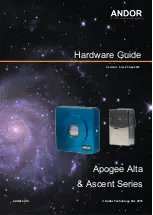
10
Version 1.5 rev 26 Sep
2016
Apogee Astronomy
Alta and Ascent Manual
SECTION 2: INSTALLATION
2.1 Installation Summary
To get the most from your Apogee camera, we recommend the following:
1. Familiarize yourself with this manual
2. Carefully unpack and inspect the contents of the box containing your camera and accessories
3. Install or update the Apogee Drivers
4. Install Maxim DL application software
5. Connect the power and signal connections to the camera
6. Begin using your Apogee camera!
2.2 General Guidelines
The following points provide additional guidelines for safe and effective setup and use of your camera:
•
Never connect or disconnect the camera from an operating computer.
•
Always ground yourself to dissipate electrostatic charge before handling the camera.
•
As much as possible, avoid contact with any of the electrical components of the camera system,
especially connector pins and the controller board edge connectors (or, "fingers").
•
Always ensure there is a good, tight physical connection between the camera, its connector cables
and the computer.
•
Make sure the power cable is securely connected to the camera and plugged into the power outlet.
•
If the camera is to be connected to a moving device, such as a telescope, be sure to secure the
cable with cable ties and allow enough slack so that the cable connector is not stressed during
movement.
•
Always allow the sensor warm up slowly.
•
Do not expose the imaging sensor to direct sunlight for prolonged periods (i.e., removing the lid
assembly or leaving the shutter open while out of doors).
•
Lightning can damage the camera components, even if it is not a direct strike. Always disconnect
the camera and remove it from grounded equipment (such as a telescope) whenever there is
thunderstorm activity in the area.
•
This is a Class A digital device - however, there is no guarantee that interference will not occur in a
particular installation. If this equipment does cause harmful interference to radio or television
reception, which can be determined by turning the equipment off and on, the user is encouraged to
try to correct the interference by one or more of the following measures:
o
Reorient or relocate the receiving antenna.
o
Increase the separation between the receiver and the equipment.
o
Connect the equipment into an outlet on a circuit different from that of the receiver.
o
Consult the dealer or an experienced radio/TV technician for help.

























